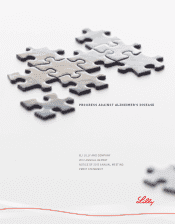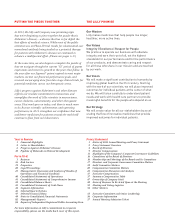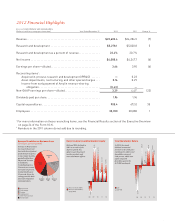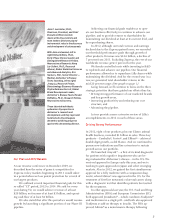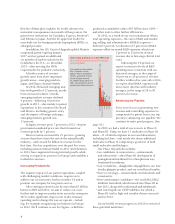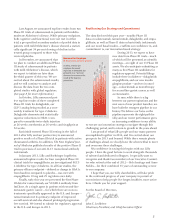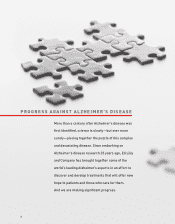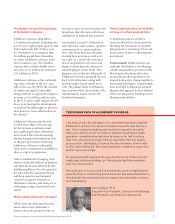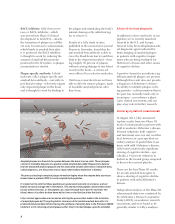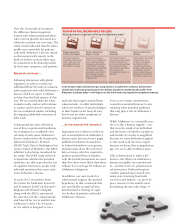Eli Lilly 2012 Annual Report Download - page 10
Download and view the complete annual report
Please find page 10 of the 2012 Eli Lilly annual report below. You can navigate through the pages in the report by either clicking on the pages listed below, or by using the keyword search tool below to find specific information within the annual report.
8
BACE inhibitor: Lilly’s beta secre-
tase, or BACE, inhibitor—which
was moved into Phase II clinical
development in mid-2012—attacks
the formation of plaques in a dier-
ent way. In contrast to solanezumab,
which binds to amyloid-beta after
it is produced, the BACE inhibitor
is thought to work by reducing the
amount of amyloid-beta proteins
produced in the rst place, so plaque
accumulation is slowed.
Plaque-specic antibody: A third
molecule, Lilly’s plaque-specic anti-
amyloid-beta antibody—currently in
preclinical testing—selectively targets
only deposited plaque in the brain
and is thought to work by binding to
the plaque and stimulating the body’s
natural clean-up cells, called microg-
lia, to remove it.
Results of a Lilly study in mice,
published in the neuroscience journal
Neuron in December, found that the
anti-amyloid-beta antibody is able to
cross the blood-brain barrier and then
bind to the deposited amyloid—clear-
ing roughly 50 percent of plaques
without causing damage to tiny blood
vessels in the brain—a serious ad-
verse eect of less selective molecules.
Until now, researchers have not been
able to directly remove plaques, made
of insoluble amyloid protein, after
they form.
Amyloid plaques are found in the spaces between the brain’s nerve cells. These plaques
consist of insoluble deposits of a peptide called amyloid-beta (Aβ). Researchers believe
that the deposited amyloid plaques and the associated soluble collections of amyloid-beta,
called oligomers, are the primary toxic impact that leads to Alzheimer’s disease.
The process leading to amyloid plaque formation begins when the enzyme beta secretase
breaks down a protein (APP) to create amyloid-beta peptides.
It’s important to note that these peptides are generated naturally in everyone, and our
bodies normally manage their elimination. The amyloid-beta peptide can be broken down
locally within the brain, or the peptide can cross the blood-brain barrier and enter the
blood, where it is either broken down by the liver or shuttled back into the brain.
Lilly’s clinical approaches are focused on altering the process that leads to the formation
of amyloid plaques by (1) targeting better clearance of the soluble amyloid-beta after it’s
produced (solanezumab), (2) decreasing the synthesis of amyloid-beta in the rst place (BACE
inhibitor), or (3) removing amyloid plaques after they’re formed (plaque-specic antibody).
A rst-of-its-kind diagnostic
In addition to these molecules in our
pipeline, we’ve recently launched
Amyvid in the U.S. and Europe.
Amyvid is the rst radiopharmaceuti-
cal diagnostic agent indicated for
brain imaging of amyloid plaques
in patients with cognitive impair-
ment who are being evaluated for
Alzheimer’s disease and other causes
of cognitive decline.
A positive Amyvid scan indicates sig-
nicant amyloid plaques are present.
Although this result does not provide
a diagnosis of Alzheimer’s disease,
the ability to identify plaques in liv-
ing patients—a determination that in
the past was normally made only in
an autopsy—can enhance a physi-
cian’s clinical assessment, and can
play a key role in further research.
Encouraging data on solanezumab
In August 2012, Lilly announced
top-line results from two Phase III
trials of solanezumab in patients with
mild-to-moderate Alzheimer’s disease.
Primary endpoints, both cognitive
and functional, were not met in either
trial; however, in a pre-specied sec-
ondary analysis of pooled data in pa-
tients with mild Alzheimer’s disease,
Lilly found a statistically signicant
slowing of cognitive decline—spe-
cically, a 34 percent reduction in
decline in the treated group compared
to those who received placebo.
These are the rst Phase III results
for an anti-amyloid-beta agent to
show a slowing of cognitive decline
in patients with mild Alzheimer’s
disease.
Independent analyses of the Phase III
solanezumab data were conducted by
the Alzheimer’s Disease Cooperative
Study (ADCS), an academic research
consortium, and were found to be
generally similar to Lilly’s analyses.

